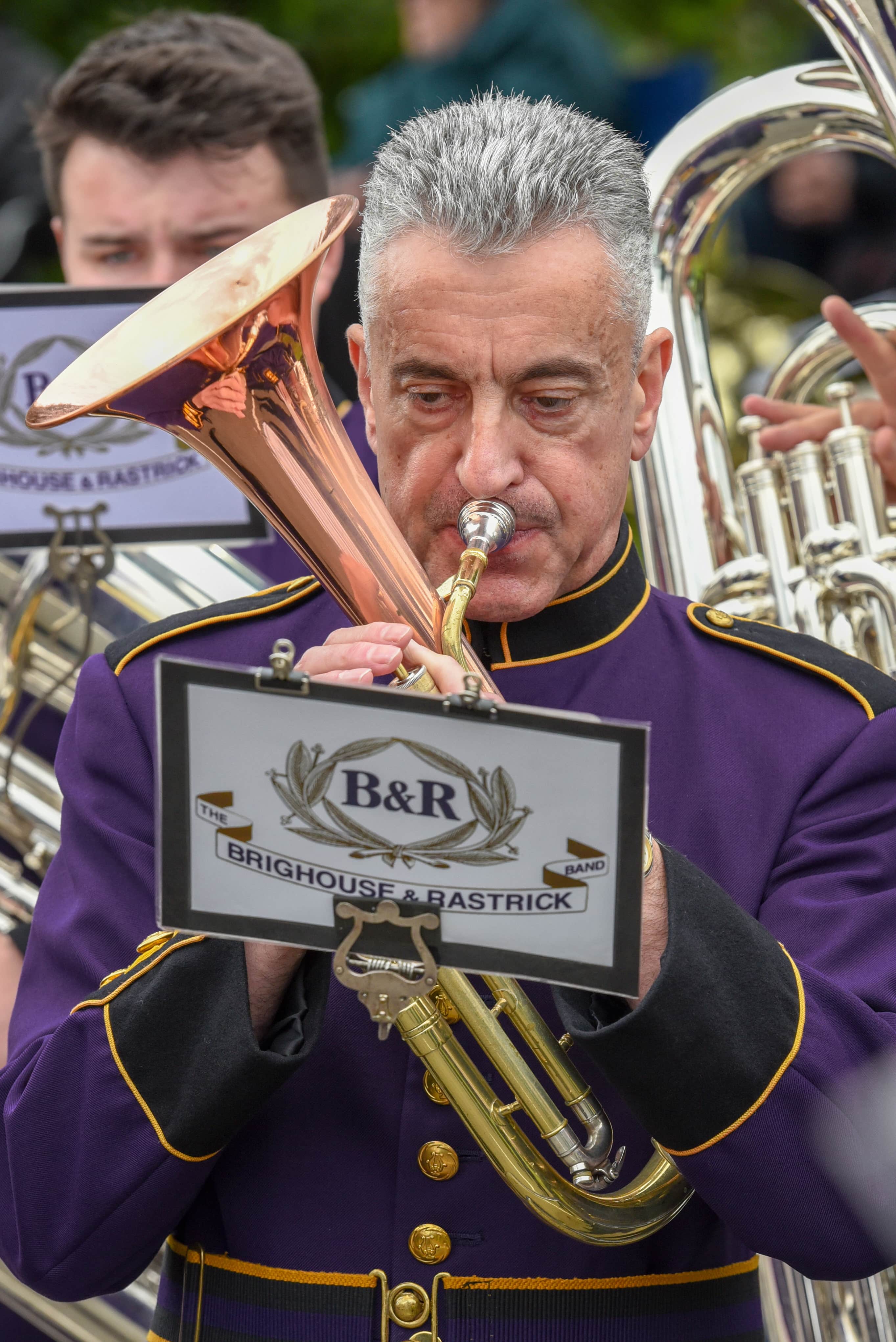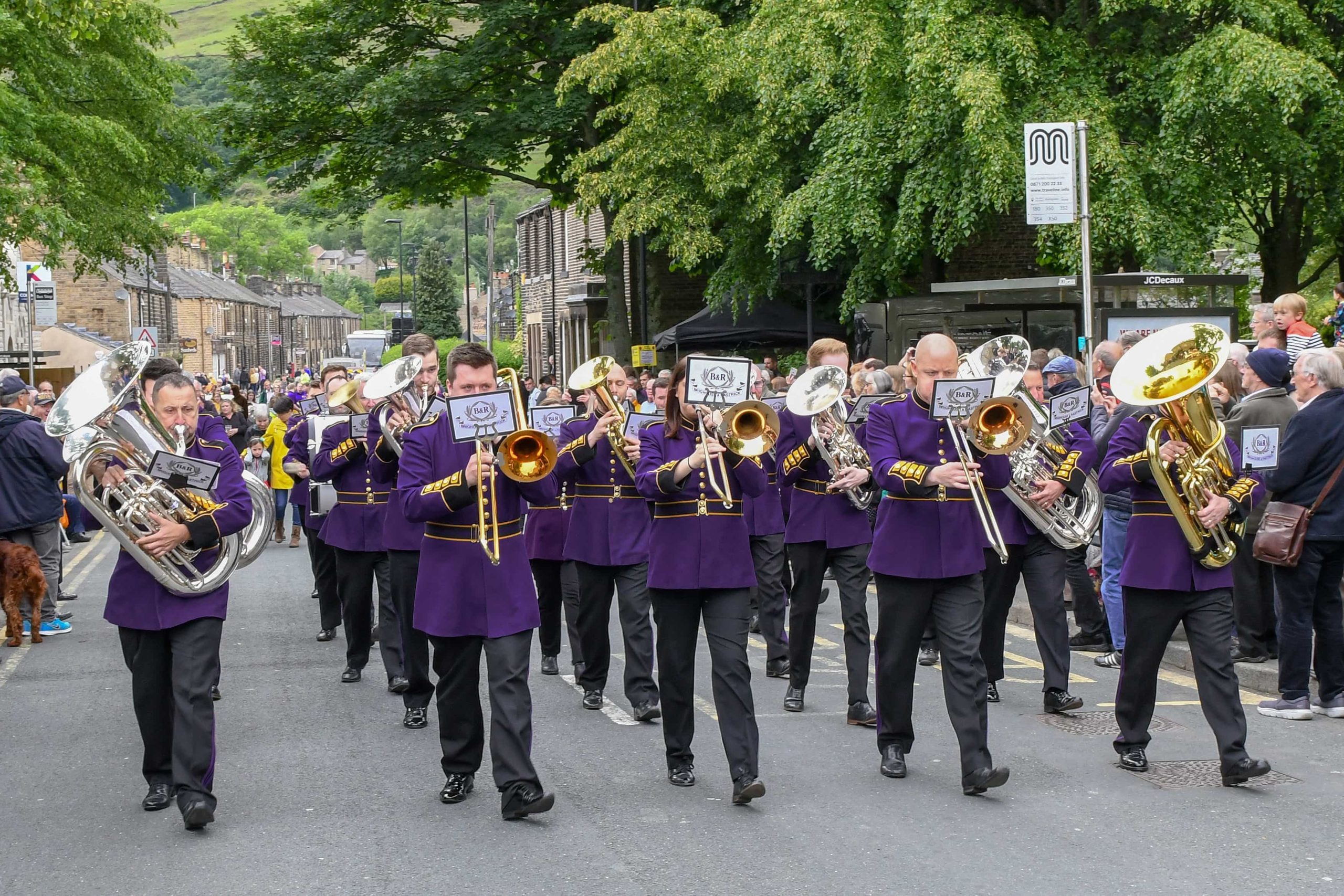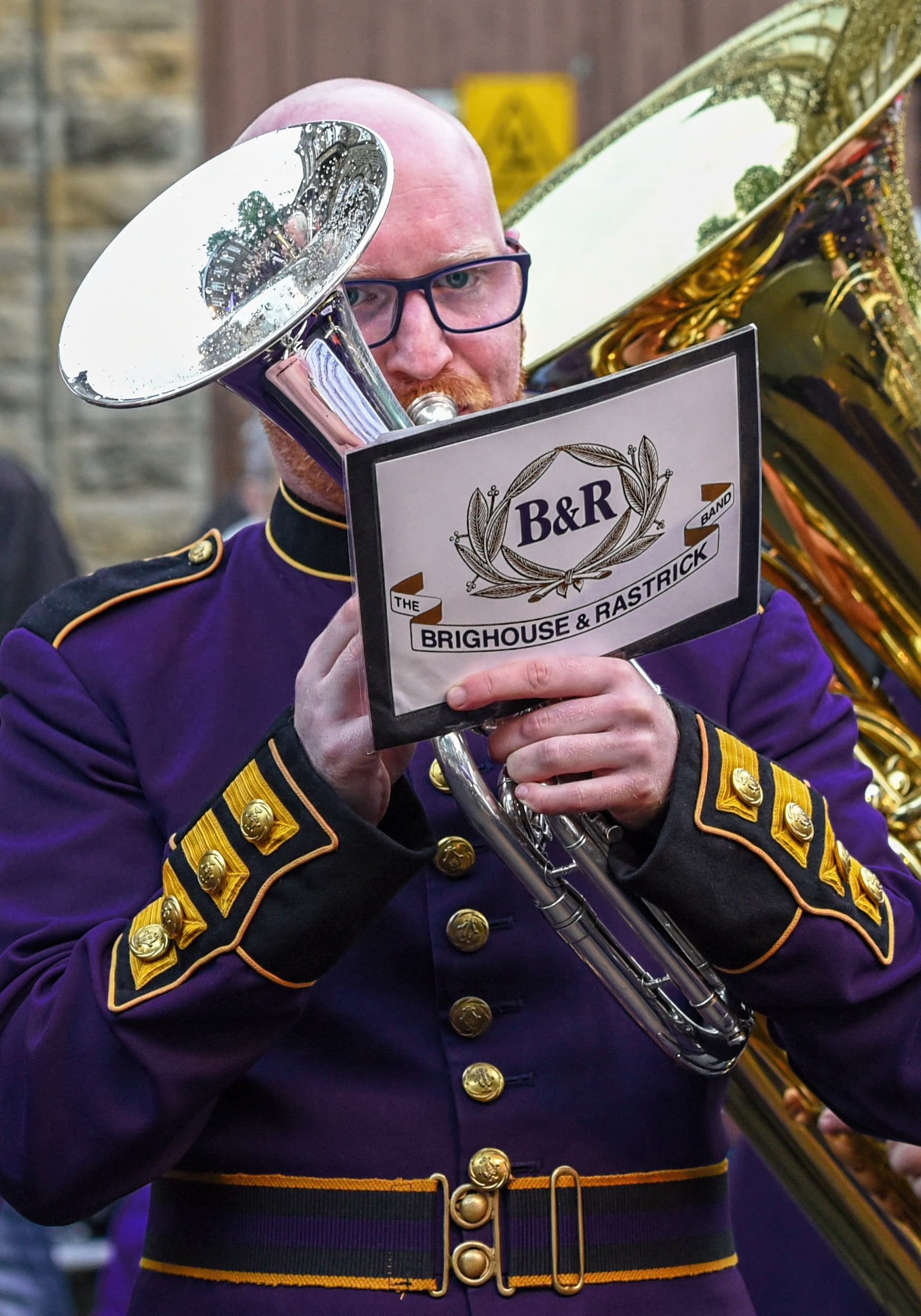Evolution of the Bands Uniforms
`One of the most distinctive features of Brighouse and Rastrick Band members, out on duty, are their unique purple and gold uniforms. At the Whit Friday Marches in Saddleworth, where many bands intermingle in their many shades of greens, reds, maroons, blues, and other uniform colours, the Brighouse and Rastrick players can always be clearly identified from the rest in their smart and distinctive outfits (shown left). Was this always the case? I am briefly going to try to tell the story of how the present day B&R uniforms evolved. Pictures from the early days of the twentieth century show the band in uniform but as colour photography was still a far off dream, the colours of the uniforms are not known and documentary evidence of these uniforms has not been found. A hand tinted photograph, displayed in the current bandroom, suggests that in the 1920’s, a uniform of brown and red might have been worn.
During the 1920’s, as we know, there was very serious determination within the ranks of B&R to “provide Brighouse with a first class band”. This extended beyond the music and included what we would today call ‘the corporate image’. The year 1927 saw musical progress being made but still the band had to achieve national recognition. Off stage a new President, Mr Herbert Wood, was appointed and was to become a very effective and generous working leader of the band and its committee of shrewd and talented administrators over many years to come. In January 1928, the committee decided to replace the existing uniforms.
These had been in regular use for 15 years. Mr Wood personally gifted £100 towards the cost of £130, the bandsmen being asked to contribute themselves to make up the £30 difference. By March 1928, the band appeared at a Celebrity Concert at the Albert Theatre in Brighouse in their new uniform colours of maroon and gold. One commentator of the time described them as “a uniform of becoming smartness and befitting a band of achievements”. The uniform was of a military style with a high collared maroon jacket with many gold buttons and trimmings. This was to serve them well during the exciting days of the late 1920’s and up to the late 1930’s when the band first made a national name for itself.
By 1937, the Brighouse and Rastrick Band had risen to National prominence. Famous for its epic hat-trick of Championship wins at Belle Vue, the band had joined the elite company of leading bands of the day. By February 1937, the committee decided again new uniforms were needed. As always, money was scarce so a special fund was set up. It was estimated £120 would be needed, this being offset by hopefully selling the existing uniforms for around £20. Hopes were high that they would be tailored and ready for the Coronation of King George VI later in that year. Much time was spent in discussion of suitable colours, but by March 1937, the ‘Royal Purple colour with plush and gold trimmings’ was decided, but the cost was now estimated at £160. Whether the coming Coronation influenced the specific choice of a regal colour we don’t know, but the people of the district were invited to subscribe to the band uniform fund. Many people did contribute, aided by the active encouragement of the Brighouse Echo’s Editor and others. The estimated cost had now risen to £170. By the time the uniforms were ready for their first public appearance, in late April 1937, at a charity concert for hospital funds at the Palace Theatre, Halifax, the cost had risen again. It was now £190. Many subscriptions had been received and the old uniforms were sold for £25. The new uniforms were the first of what we now call ‘the Whit Friday uniforms’. The jackets were again of military style with high collar, single vertical row of buttons, gold trimmings worn with a tight belt and resembled the scarlet Guards Division uniforms, but in Royal purple. Matching purple and black peaked caps with gold trimmings were worn along with black trousers and shoes. This style was to continue in use through the turbulent years for country and band from 1937 into the 1950’s.
What influenced a change in the early 1950’s we don’t know. Maybe it was fashion in general or was the military influence felt? Many of the bandsmen would have given military service in the recent war and would probably have seen the smart evening dress uniforms worn by Officers when dining in the Mess. What we do know is that our distinctive and familiar purple and gold ‘mess jackets’, white shirt and bow tie with black trousers with purple seam stripes were first worn in a massed band concert in Huddersfield Town Hall in October 1952, and the style continues in use today. This ‘concert’ uniform has undergone some slight changes over the years as fashions have changed. In the early 1970’s the jackets were almost devoid of gold being mainly purple and black. After a few years the greater use of gold was reintroduced and extra trimmings and gold decoration were applied to the jacket backs. This is the uniform in use today for the majority of our concert hall performances.
Up to the mid 1970’s, the band travelled to all its concert and contest engagements in civilian clothes. Some bandsmen bought black blazers at their own expense to wear when travelling but we had no walking-out (travelling) uniforms. To provide these would be another burden on an already tight budget trying to fund instruments, music, existing uniforms, rehearsal facilities etc. A rare weekend concert trip to Holland in the mid 1970’s, along with the Fairey Band, brought the need for this uniform to the serious attention of the then committee.
Despite the best efforts of both band’s secretaries who were co-ordinating travel arrangements, the airline concerned did not taken sufficient notice of the fact that they had to fly out to Holland in one aeroplane about sixty band personnel complete with their personal luggage and their brass and percussion instruments. Upon arrival at East Midlands Airport, both bands were faced with a major problem. There was space for the band personnel but only their luggage or the instruments – not both! As both bands were to appear in a massed concert together that evening in Kerkrade, the instruments accompanied the bandsmen, but not the luggage containing the concert uniforms. The Fairey Band had at this time smart walking-out blazers, shirts ties etc. and appeared at that concert looking quite smart in travelling uniform. Meanwhile, B&R, travelling in their usual mix of civilian clothes, gave a far from smart appearance and probably gave the only full concert performance out of uniform in their history. The luggage was flown over later in the day but only caught up with the two bands after the evening concert had ended. The rest of the short concert tour proceeded successfully without incident, but a lesson had been learnt for the future.
Upon arrival home, the committee quickly thought around the problem, examining all possibilities and options. As is often the case, the response to a crisis goes a little ‘over the top’. Sports style jackets with chequered patterns in bright modern colours with contrasting coloured shirts and ties were in vogue. They could be easily bought ‘off the peg’ and were quite reasonably priced. The committee went for this option and the band were duly kitted out in their first official walking out uniform, christened by the bandsmen, ‘the Rupert gear’. It consisted of chequered jacket made up of predominantly light blue and grey with a touch of red, dark blue shirts, light blue ties and dark grey slacks. What a picture! In fact, they once wore this uniform in a Granada TV Band of the Year Contest at Belle Vue, Manchester when the visual entertainment of a performance was part of the competition. It only lasted around two years although a photograph exists showing the band still in this outfit at BBC TV Studios, Birmingham in ‘The Floral Dance days’ in 1977. Probably as a result of slightly better finances brought about by the band joining the ‘popular music culture’ of the time, the current walking-out uniform, black blazer with badge, white shirt, official band tie, grey trousers and black shoes was purchased and introduced.


This brings us fully up-to-date. The ‘mess jacket uniform’ is still used for the majority of concerts, whilst the ‘Whit Friday (outdoor) uniform’ is used especially on Whit Friday and the occasional concert especially out-of-doors, the jackets are very warm.
The ‘walking-out uniform’ is worn on all concert and concert engagements when personnel are not on stage and when the band is travelling as a unit. Next time you see the band in those famous purple and gold colours, please consider the thought and care that has been taken to produce our unique and distinctive visual identity, including the ‘Rupert gear’!
Thanks to the late E.Noble, D.Rawlinson & S.Fryer for data contributing to this story.

